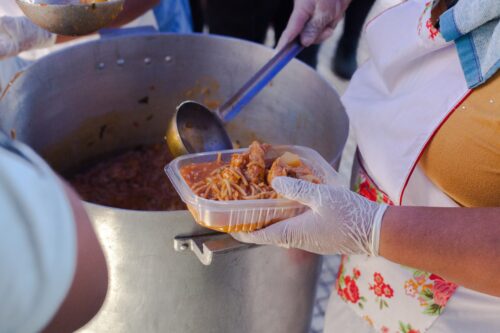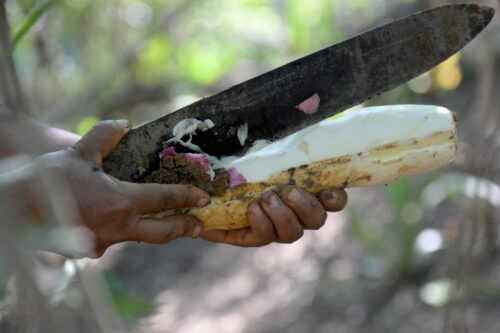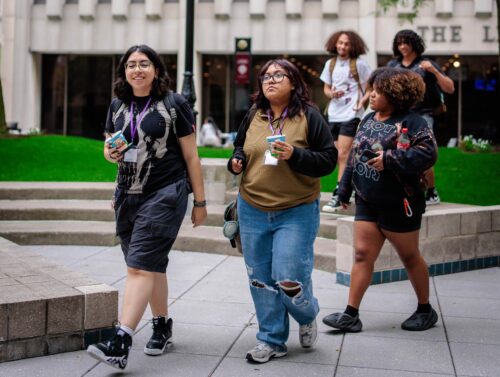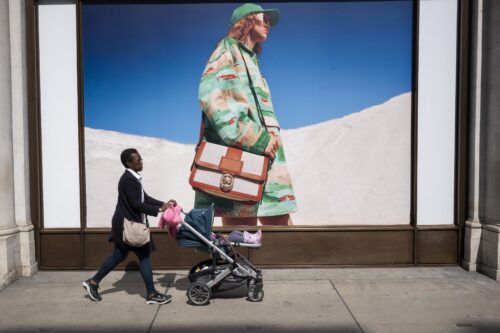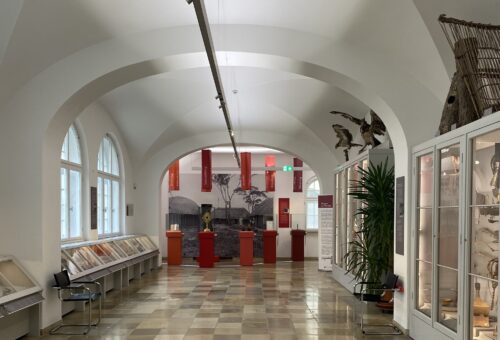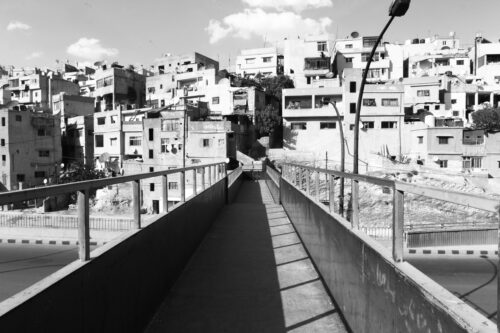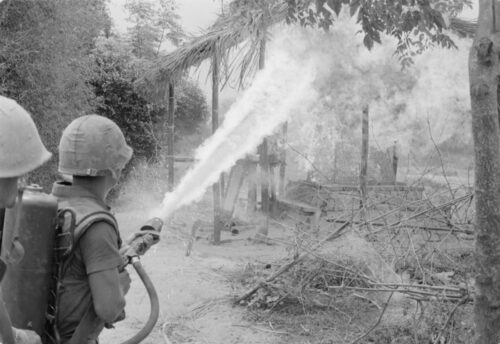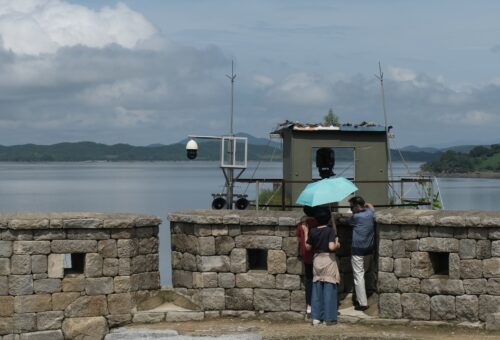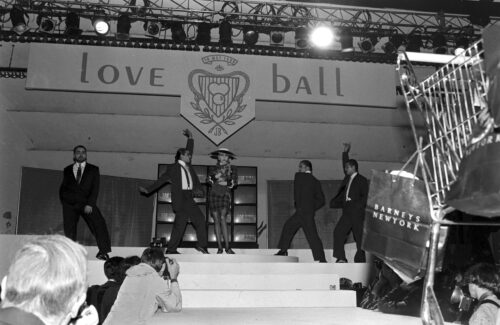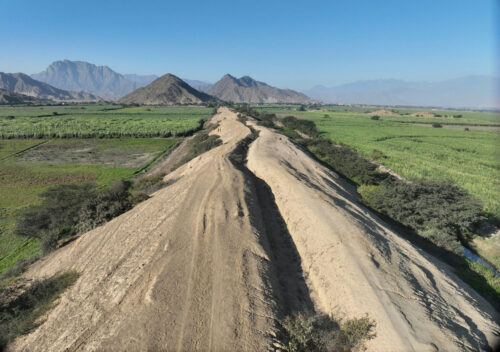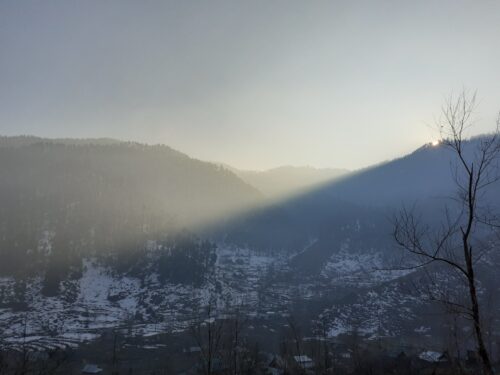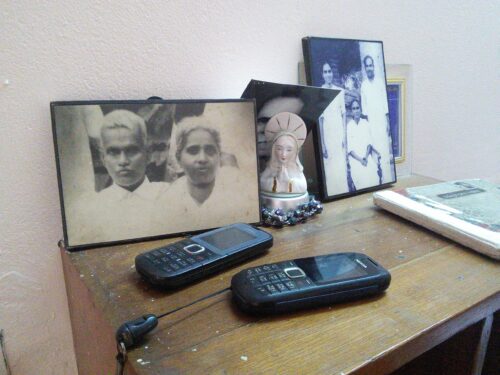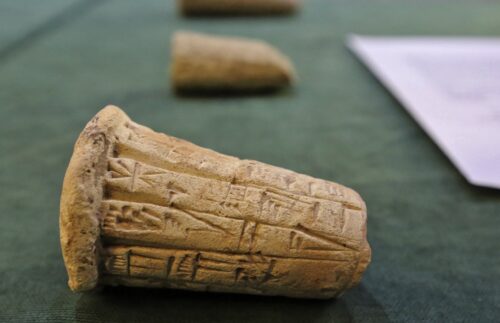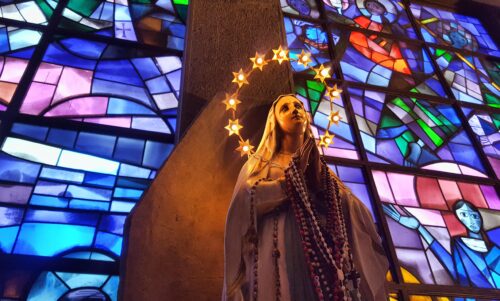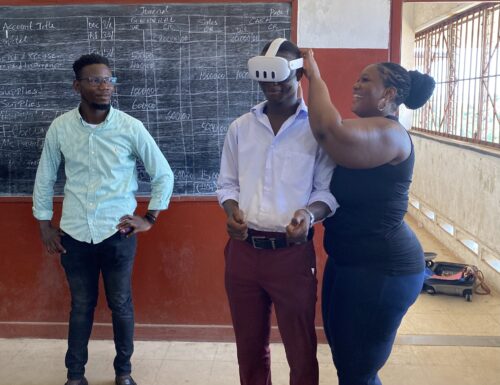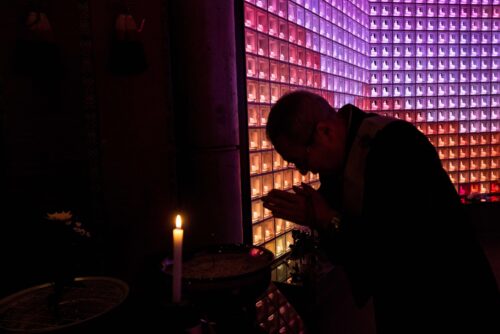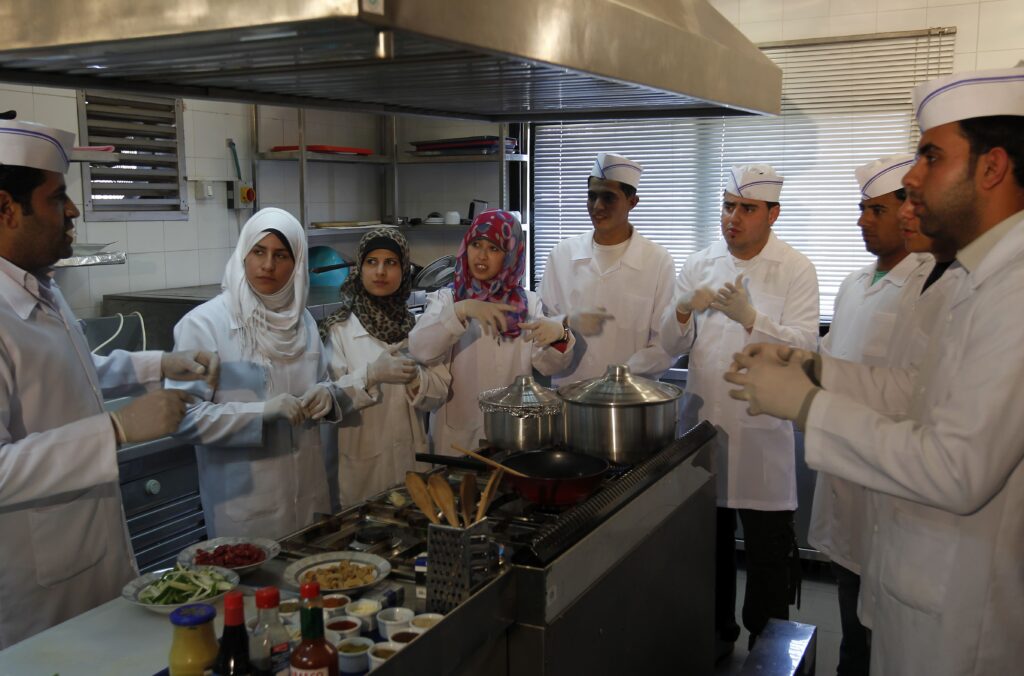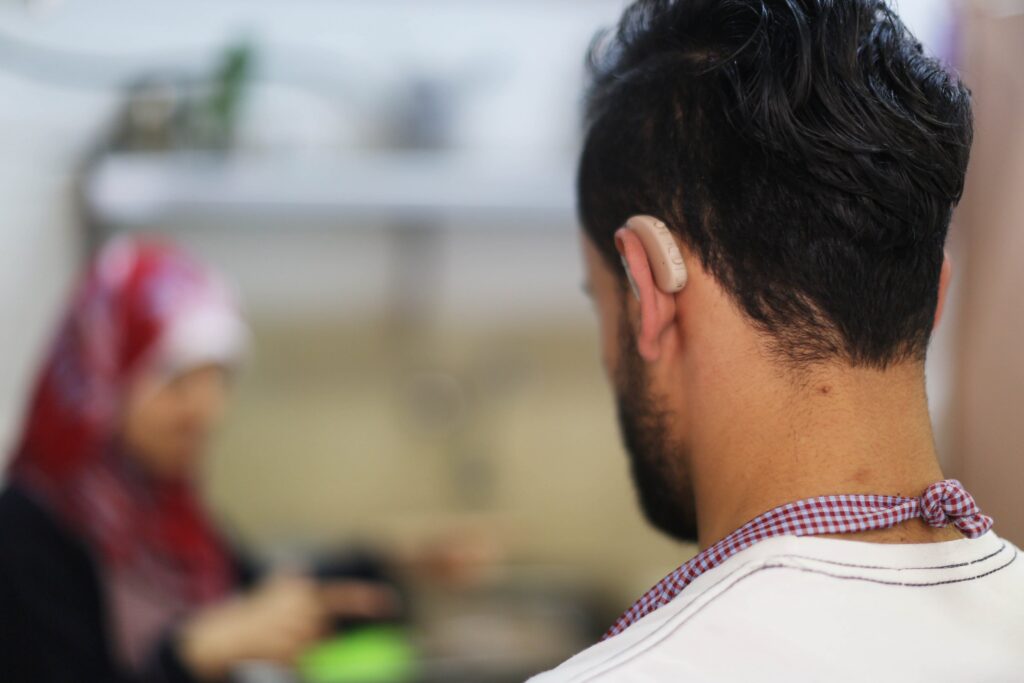Gaza’s Deaf Community in the Face of Genocide
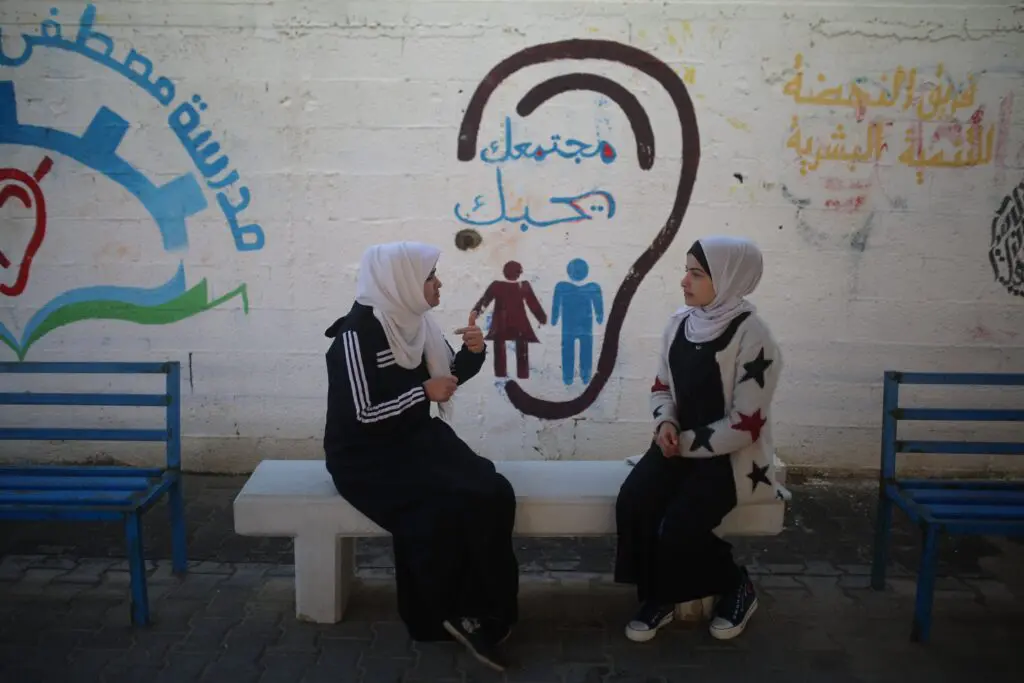
On March 6, 2024, I woke up to the horrific news that the Israeli military had bombed the building of the Atfaluna Society for Deaf Children (ASDC) in Gaza City, part of the ongoing war on Gaza that began last October. In one photo that made the rounds on my social media feeds, Israeli soldiers pose in full gear, gripping their rifles, in front of the school while the building burns behind them. Another depicted the aftermath of the military assault: windows shattered, rubble strewn, letters missing from the school’s sign—a shadow of its former self.
Off The Grid Missions, a Deaf-led disaster response organization that posted the pictures, wrote in a caption, “While this is not the first school Israel has attacked using bombs and white phosphorous, this was an attack on what was once a safe and empowering place for Deaf and Disabled children and directly affects our community and the people we serve.” At the time, they did not know the whereabouts of the children and staff. [1] [1] In some circles, the use of capitalization for “Deaf” and “Disabled” indicates a cultural identity rather than a medical diagnosis. In this essay, I do not capitalize these terms unless the people and organizations I am referring to self-identify as such.
As one of perhaps only two schools for deaf people in Gaza, the bombing of the ASDC was a devastating loss. [2] [2] Due to the ongoing occupation, it is not clear exactly how many deaf schools there are in Gaza, although internet research reveals at least two: the ASDC and the Mustafa Sadiq Rafii school. Audiologist and speech therapist Raja Sharaf also mentions the presence of specialized centers and schools for deaf children in Gaza. The ASDC, established in 1992, is not just an educational institution but a nonprofit organization that provides a whole host of services to deaf Gazans, including vocational training, audiology and speech therapy, community training and awareness-raising programs, and even a restaurant.
Two months later, the deaf community in Gaza experienced another loss when one of its prominent members, Hashem Ghazal—carpenter, Palestinian Sign Language teacher, and disability rights advocate—was murdered in an Israeli airstrike that also killed his wife and wounded seven of his children. As I was completing this essay, the ASDC announced the death of yet another one of their employees due to the ongoing war, Anwar Al Zaeem, who had worked for them for 30 years.
I have never been to Gaza, which has been under siege since 2007 and whose borders are controlled by Israel. But I still felt these losses deeply.
I am a hearing anthropologist who studies deafness, disability, and assistive technologies in Jordan and the broader Arabic-speaking Middle East. I’ve lived for close to four years in Jordan and have spent extended periods of time in Egypt, Lebanon, and other parts of occupied Palestine. Many of the people I know through my research in Jordan are Palestinian, have family in Palestine, and/or are of Palestinian descent.
Read more from the SAPIENS archives: “Living as Stateless Palestinians in Jordan.”
In 2016, as a master’s student, I published an article in Boston University’s Pardee Periodical (now The Pardee Atlas: Journal of Global Affairs) about a new initiative at the ASDC to support their students. Many of them had been severely traumatized during Israel’s so-called Operation Protective Edge in summer 2014. After the kidnapping and murder of three Israeli teenagers in the West Bank, Israeli security forces led a military offensive into the Gaza Strip that took the lives of more than 2,000 Palestinians. In response, the school started a project in which deaf students produced short animated films about their experiences of the war and their lives in Gaza. Through my research, including an email interview with ASDC staff, I came to understand this project not only as a powerful form of art therapy but also of nonviolent resistance against decades of Israeli settler-colonial occupation.
Rereading what I wrote then about deaf students at the ASDC while witnessing the flattening of Gaza 10 years later feels chilling—a visceral reminder that the history of Palestine, as numerous commentators have observed, did not begin on October 7, 2023. On top of the starvation, displacement, bombings, and other forms of physical and psychological violence that all Palestinians in Gaza are experiencing in this brutal, ongoing assault, deaf Gazans face additional vulnerabilities that are heightened during times of war.
WARTIME FOR DEAF GAZANS
Under constant bombardment, many deaf Palestinians in Gaza—about 15,000 people in a population of 1.8 million—find themselves in acutely dangerous situations. They might feel tremors and see things shaking around them, but they cannot hear the shelling. Nor can many of them hear the evacuation “warning” sirens from the Israeli military before an imminent attack. In both cases, they must rely on family, friends, and neighbors to keep them abreast of any dangers and to let them know when and where to run to escape the bombing.
But communication between deaf and hearing people, including in Palestine, is no straightforward feat. An estimated 90–95 percent of deaf children around the world are born to hearing parents who do not know a signed language and may not have a way to communicate with their families beyond the basics. These communication limitations are compounded by the complexities of the war on Gaza and Israeli occupation. As a staff member at the ASDC explained in 2015 in reference to the Israeli military operation, “Not all families were able to use sign language to explain the reason behind the brutality.” For many of the children, all they would see was their families fleeing their homes, without fully understanding the situation.
Such fear and isolation is only being exacerbated in this genocide, which impacts not only deaf Palestinians in Gaza but those in the West Bank as well. Even for those deaf Palestinians whose families do know sign language or share a kind of homesign system, blackouts due to power cuts by the Israeli government make communication in a visual-gestural language even more difficult at night. Signing deaf Palestinians also fear that they might lose their arms and thus their ability to communicate in a bombing or a military assault, which indeed has happened to some members of the community.
The war has also severely impacted deaf Palestinians reliant on assistive devices and technologies such as hearing aids and cochlear implants. In a recent commentary for the Journal for the Anthropology of North America, anthropologists Michele Friedner and Christine Sargent describe a conference in December 2023 in Amman, Jordan, that Friedner attended with journalists reporting on disability-related topics in the Middle East. At the conference, they discussed “how uncomfortable and jarring it was to think about procuring expensive devices and trying to maintain them during a genocide.”
The war has made it nearly impossible for deaf Gazans to charge their devices, to get their hands on batteries and other essential accessories, and to access medical services like aural rehabilitation and speech therapy. These aids and appliances, as Friedner writes, “make sensoriums and lives”—which are actively being destroyed in this war.
DISABILITY JUSTICE IN PALESTINE AND BEYOND
All this demonstrates, as disability activists like Allie Cannington, Alice Wong, and Leah Lakshmi Piepzna-Samarasinha and disability organizations like Sins Invalid and the Abolition and Disability Justice Collective have cogently argued—even before the events of October 7—that solidarity with Palestine is also a disability justice issue.
Israel’s genocidal war endangers deaf and disabled Palestinians disproportionately. It is also a cause of disability. The weapons of war injure bodies, break bones, burst eardrums, and blind eyes. In 2017, disability studies scholar Jasbir Puar described these disabling conditions as the result of Israel’s “right to maim.” These conditions have now shifted to what Sargent and Friedner call an “unapologetic will to massacre.”
Israel presents itself as committed to upholding the rights of persons with disabilities and as a model for accessibility in the region. However, their actions in Gaza demonstrate that this commitment does not extend to Palestinians, whom Israel, as the occupying power, is responsible for ensuring the humane treatment of under international law.
Disability scholars and activists push back against what they recognize as Israel’s “disability-washing” and “accessibility washing,” or using the rhetoric of disability rights to deflect attention away from other human rights abuses while at the same time justifying those abuses. They also resist corporate and government efforts to use technologies designed for accessibility to wage war, such as through the development of weaponized prosthetics.
As activist Nelly Bassily writes, “Israel cannot on the one hand ratify the United Nations Convention on the Rights of Persons with Disabilities and on the other hand maim and disable Palestinians with brutal imperialist colonial force.”
These scholars and activists recognize, as disabled Palestinians themselves do, that “disability rights cannot exist in absence of other foundational rights, such as the right to health care, food and water, and shelter,” as Sargent and Friedner explain.
Over the past year, like many of their hearing and able-bodied counterparts, deaf and disabled Palestinians have been taking to social media to show conditions on the ground in Palestine. These include Basem Alhabel (recently featured by Middle East Eye and UN News), Kamal Ghazal, and Nabeel Al Shokri. Such efforts are also being carried out by deaf Palestinians in the diaspora as part of the larger Palestinian solidarity movement. For instance, Ranem Shhadeh, who is Deaf and Palestinian American, leads Access Palestine and the Olive Guardians, an organization working to make information about Palestine accessible for international deaf audiences through sign language interpretation and captioning, in-person and online.
Meanwhile, in Palestine, the ASDC continues to provide as many of its services as possible, despite the loss of their main building, collaborating with other organizations to support displaced Gazans with and without disabilities. Amid death and destruction, the ASDC—now operating out of a tent—is hosting psychosocial support sessions for displaced families, feeding families living in shelters, distributing hearing aids to deaf children, and providing inclusive education for students.
Deaf Palestinians embody sumud, steadfastness in the face of unrelenting violence. As an anthropologist, I follow their lead: to persist in bearing witness, in teaching about disability, and in speaking out against injustice, in Palestine and elsewhere.

